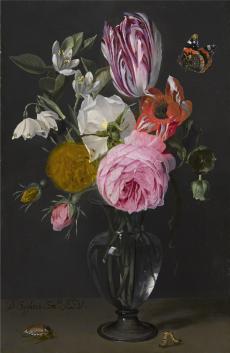


In a façon-de-Venise glass vase upon which reflections of the artist’s studio are visible, we see a small but beautiful array of flowers and insects set against a dark, impenetrable background. The vase is filled with, among other flowers, a pink and a white rose (Rosa provincialis and Rosa alba), a purple and white tulip (Tulipa clusiana), orange blossom (Citrus aurantiacum) and the remnants of a yellow rose (Rosa foetida), whose paint layer has deteriorated over the course of time. Moreover, this charming little scene is enlivened by a Red Admiral butterfly in the upper-right corner, a beetle in the lower left and a half dozen caterpillars – a big larva crawls on the right of the foot of the vase, while five little ones are on the brink of falling from the leaves next to the rose. To the left of the vase the artist has placed his characteristic signature, which mentions his membership of the Jesuit Order: D. Seghers. Soc.tis JESU. Daniel Seghers had been a member of the Jesuits since 1614, when he entered as a lay brother in Mechelen; he took his final vows as a Jesuit priest in 1625 in Antwerp. From then onwards he signed his works in the manner we see on this Still Life with Flowers in a Glass Vase; sometimes he made use of the monogram DS (interlaced), but the reference to his religious order is always present.
Like many artists of his generation, Seghers had a peripatetic upbringing. He was born in Antwerp on 3 December 1590, the son of a silk merchant, but was brought up in the Northern Netherlands, to where his widowed mother had emigrated. She had converted to Calvinism and also raised her son as a Protestant in the United Provinces. It was there that from c. 1605 onwards Seghers was first trained as an artist, perhaps in Utrecht. After the signing in 1609 of the Twelve Years’ Truce between the Northern and the Southern Netherlands, mother and son returned to Antwerp, where in 1610 Seghers became a pupil of Jan Brueghel the Elder (1568-1625), the most renowned landscape and still-life painter of his day. Seghers enrolled as a master in the Antwerp Guild of St Luke in 1611. Apparently Brueghel also influenced Seghers’ reversion to Catholicism. After his ordination, Seghers was first sent to Rome, where he stayed until 1627. In that year he was back in Antwerp, where he remained until his death on 2 November 1661, working as a flower painter in the house (domus professa) of his Order. Clearly the Jesuits encouraged him to paint. The majority of his paintings were not sold, but were presented by the artist and his Order to dignitaries across Europe as tokens of honour and esteem. They adorned churches and cloisters, but were also present in the collections of high church officials and more worldly rulers, such as Queen Christina of Sweden, Frederick Henry, Prince of Orange, King Philip IV of Spain and Emperor Ferdinand III, among many others. The artist was honoured by his contemporaries in prose and verse, and his studio was visited by such personalities as the Cardinal-Infante Ferdinand in 1635, Marie Louise, Queen of Poland, in 1645 and the Archduke Leopold Wilhelm in 1648.
Seghers painted flower pieces, wreaths, garlands and floral cartouches. Among the artists who painted religious scenes in the centre of his cartouches were Peter Paul Rubens (1577-1640), Cornelis Schut (1597-1655) and Erasmus Quellinus (1607-1678). Seghers very rarely painted ‘secular’ flower pieces like the one in the A. G. Leventis Collection. The artist kept a record of his paintings, and from this it is clear that, from the 239 listed paintings, only 58 were ‘een glasken met blommen’ [a little glass with flowers]. Of these 58, presently only about 20 are known, so the work presented here is quite a rarity. This simple flower piece is in a very good condition and it shows the specific combination of opaque paint and glazing layers, which are so characteristic of the artist. The yellow rose was painted with the use of the pigment orpiment (king’s yellow), and this material deteriorates naturally when it is not applied correctly; we see this in other works by Seghers.
The artist rarely dated his works, but between 1635 and 1660 he placed a date on a few of his large pictures. Stylistically, Still Life with Flowers in a Glass Vase can be compared with a work with the same title from 1635 in Toledo, Ohio, and a flower piece dated 1643, which formerly hung in Dresden. Therefore, we may assume that the A. G. Leventis Collection painting was likewise made at the end of the 1630s or perhaps the beginning of the 1640s. In any case, the solid rendition with its vigorously modelled buds, leaves and stalks, in combination with the subtle light falling through the vase and the humorous detail of the little caterpillars clinging to their leaves, make clear that we are looking at the work of a master at the peak of his powers. Judging by this excellent work, we can fully share the feelings of an important contemporary Dutch poet, Constantijn Huygens, who wrote laudatory verses about one of the flower pieces he had received from Seghers in 1645: Siet, de geschapen’ Roos werdt weer een dorre plant; Maer uw’ geschilderde is een eeuwig Amarant. [Look, the natural rose becomes an arid plant; but your painted one is forever amaranth.]
Active in Antwerp, he studied with Jan Brueghel the Elder. He became the leading Flemish flower still-life painter of his generation, and his works, with their scrupulous accuracy in depicting flowers and insects, influenced many artists across Europe. In 1614 he became a Jesuit brother and was later ordained; many of his works were presented by the Jesuit Order as gifts to dignitaries. He often worked with other artists by painting garlands of flowers around their religious images.